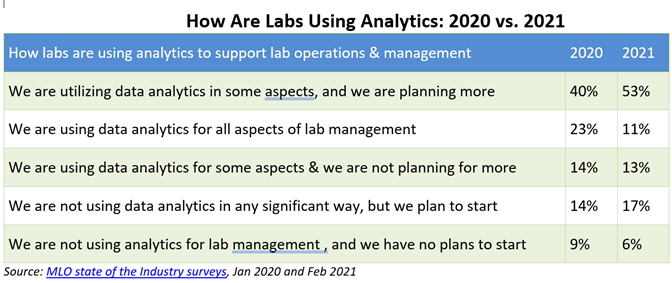 Today’s lab is a high data throughput environment. Nearly all of your equipment is capturing data, and key analytical systems are capturing more data than ever before. As the pace, volume and variety of data increase, the use of analytics has become essential to creating operational efficiencies.
Today’s lab is a high data throughput environment. Nearly all of your equipment is capturing data, and key analytical systems are capturing more data than ever before. As the pace, volume and variety of data increase, the use of analytics has become essential to creating operational efficiencies.
The Role of Analytics in Today’s Lab
Enabling laboratories to assess and optimize performance, identify operational inefficiencies, and perform the root cause of identified problem areas are key functions of analytics. It enables benchmarking performance and drives continuous improvement by monitoring a comprehensive list of key performance metrics.
Analytics can provide laboratories with both leading and lagging indicators for performance, helping with both reactive and proactive decision making. Along with the analysis of KPIs on historical data, today’s Artificial Intelligence/Machine Learning (AI/ML) algorithms generate predictive and prescriptive insights for the laboratory to drive improvements in both quality and operational efficiency.
Laboratories are using increasingly sophisticated approaches to data analytics to improve their operations and gain competitive advantage. According to Medical Laboratory Observer’s 2021 State of the Industry survey, 77% of labs are now using analytics, with various levels of maturity.
To drive deeper insights, a fundamental step is to create a consolidated view of lab data – a ‘single source of truth’ (SSOT) in a laboratory. Access to accurate, timely and comprehensive data provides labs the ability to perform advanced analytics for continuous improvement.
This is where advanced, end-to-end AI platforms such as LabVantage Analytics come into play. Such platforms not only support advanced data analytics and visualizations, but also use cutting edge technology to ingest data from various data sources (both in batch and real-time) and store the data, creating a single source of truth for laboratories. Such AI platforms offer users a wide array of artificial intelligence, machine learning and deep learning algorithms to help solve some of the most complex problems facing today’s labs.
Lab Analytics Use Cases
What are some common business cases for using laboratory analytics across various industries?
- Manufacturing
Perform quality related analytics combining lab data with production process data to identify drivers of poor quality & recommend real time intervention strategies.Impact: Reduces the costs associated with poor quality in manufacturing.
- Material Science
Predict a recipe that uses a chosen set of raw materials & meets the desired specifications; how a new recipe performs in a given application or how a historical recipe performs in a new application.Impact: Reduces the cost from failed experiments in R&D laboratories.
- Food Processing
Identify processing unit areas to swab for checking the presence of Listeria and other contaminants based on a data driven risk assessment of different surfaces for improved quality control.Impact: Improves quality of the end product.
- Pharmaceuticals
Generate the best fit standard curve using known concentrations of the analyte being assayed or perform analysis related to PK/PD Modeling including population pharmacokinetics.Impact: Improves turn-around time for analysis and reduces cost through increased efficiency and better accuracy.
- Biotechnology

Compute immunogenicity cut-points and assay sensitivity, with computations for screening assay, confirmatory assays, neutralizing assay, including both parametric & non-parametric analysis.Impact: Improves turn-around time for analysis and reduces cost through increased efficiency and better accuracy.
The ROI of Lab Analytics
The overall ROI of analytics in the laboratory is substantial, as it leads to a significant reduction of operational costs through increased efficiencies and potential improvements in overall quality. Benefits include:
- Improved resource planning and scheduling: Plan work and resource allocation based on resource availability and current/predicted workload. This reduces turnaround times by balancing work between the available resources.
- Improved material management: Leverage predictive insights to manage lab materials, inventory items and consumables – including tracking & distribution of materials and traceability of test results to standards & reagents used.
- Improved instrument management: Track instrument data in real-time to assess and improve the utilization of instruments and identify signals for preventive and predictive maintenance.
- Improved cost analysis: Leverage trend and cross-sectional analysis of costs leading to the identification of high-cost pools and associated cost drivers, leading to better cost management.
- Improved lab efficiency and throughput: Analyze lab data to identify root causes of bottlenecks driving delays in labs. Removal of such bottlenecks reduces TAT for requests/tests and improves throughput.
- Improved quality management: Perform quality-related analytics with statistical process control.
- Benchmarking across labs to maximize ROI: Compare relative costs and TAT for tests in different labs and recommend which and when high margin tests should be performed to maximize overall ROI for the lab.
- Improved insights from experiments: Provide R&D labs a comprehensive view across labs to avoid repetition of experiments – leading to significant cost and time savings.

In the future, laboratories will not only look at using data to be more efficient within the laboratory, but also merge the lab’s data with other data sets to gain comprehensive insights – multiplying the ROI from data analytics.
 Laboratories that leverage their data assets with data analytics are more likely to thrive in several ways:
Laboratories that leverage their data assets with data analytics are more likely to thrive in several ways:
- Improved operational efficiencies by enabling optimal use of laboratory resources, leading to cost reductions.
- Improved quality for both finished goods and intermediary products, thus reducing the cost of poor quality.
- Improved innovation lifecycle with insights driven by internal lab data, in conjunction with external data.
Want to accelerate the impact of LabVantage LIMS with Analytics? Contact us today to get started!




